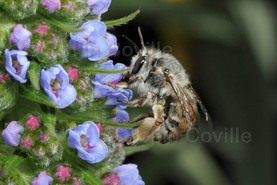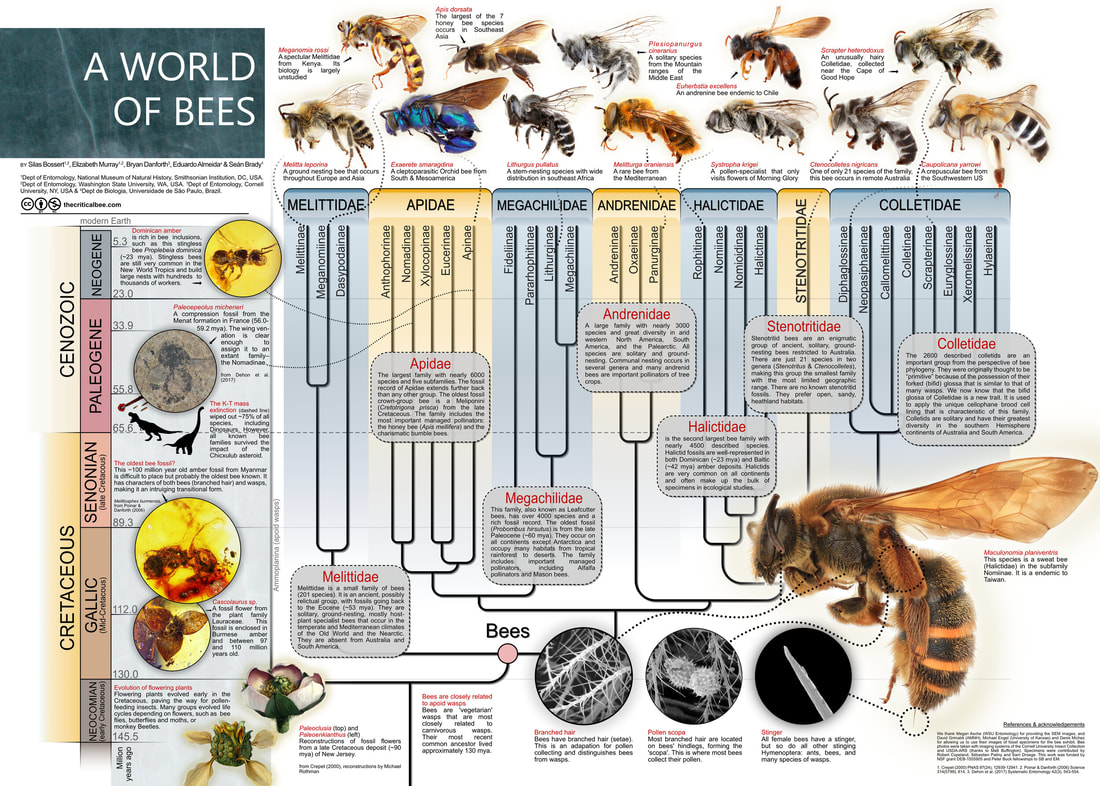Bees: How diverse can they be?

Female digger bee on Pride of Madeira
When you think of bees, typically honey bees or bumble bees are the first to come to mind. However, these two bees represent only a fraction of the vast varieties – there are over 1,600 native species just within the state of California, including carpenter, leafcutting, and cuckoo bees.
These species vary not only in body size and coloring but differ in behavior and strategies, as well. Even within the same families or orders, certain species can vary greatly.
Behavior
The classic image of typical bee life – every busy bee playing a role to defend, forage, or reproduce in a large hive led by a queen– reflects the behavior of honeybees and similar species. However, this “social” behavior only makes up a minority of all bee behaviors.
More often than not, bees are solitary rather than social, meaning that they raise offspring and run a nest of their own, rather than having separate jobs within a large community. They can also be parasitic and lay offspring in another bee’s nest – a complete turn from the “all in this together” stereotype of bee behavior.
Nesting
Bee habitats are not limited to the quintessential above-ground hive. Many species live in hollowed pieces of wood or dig nests in the dirt. For those that do build rather than burrow, some use leaves while others use tiny plant fibers or hairs.
Size and Shape
Native California bees range from a few millimeters long to over two centimeters long. Many of these smaller bees are often mistaken for entirely different insects altogether – like gnats or tiny wasps – and are batted away. The larger species, such as carpenter bees, are unmistakable and can be so big that plants they visit may sag from their weight.
Some bees have rounded abdomens while others are tapered and come to a point. Some have long, slender bodies whereas others can be quite robust. Some carry pollen on their legs while others gather it on their abdomen. Species such as leafcutters – bees with large heads and muscles to cut leaf discs – have different physical features entirely.
Color
Bees are not limited to the classic black and yellow. In fact, you can encounter bright green bees or metallic blue bees from your own garden. Entomologists have several theories as to why these different colors and patterns evolved. One thought is that bright colors serve as warnings to predators. Another is that the colors help with mate or intra-species recognition.
Next time you see a bee, take a good look. Thousands of species exist in our backyard that are often ignored. Find a bee that lives underground or a species that shines bright blue. You’ll be surprised how many new bees you’ll find with a little more attention.
These species vary not only in body size and coloring but differ in behavior and strategies, as well. Even within the same families or orders, certain species can vary greatly.
Behavior
The classic image of typical bee life – every busy bee playing a role to defend, forage, or reproduce in a large hive led by a queen– reflects the behavior of honeybees and similar species. However, this “social” behavior only makes up a minority of all bee behaviors.
More often than not, bees are solitary rather than social, meaning that they raise offspring and run a nest of their own, rather than having separate jobs within a large community. They can also be parasitic and lay offspring in another bee’s nest – a complete turn from the “all in this together” stereotype of bee behavior.
Nesting
Bee habitats are not limited to the quintessential above-ground hive. Many species live in hollowed pieces of wood or dig nests in the dirt. For those that do build rather than burrow, some use leaves while others use tiny plant fibers or hairs.
Size and Shape
Native California bees range from a few millimeters long to over two centimeters long. Many of these smaller bees are often mistaken for entirely different insects altogether – like gnats or tiny wasps – and are batted away. The larger species, such as carpenter bees, are unmistakable and can be so big that plants they visit may sag from their weight.
Some bees have rounded abdomens while others are tapered and come to a point. Some have long, slender bodies whereas others can be quite robust. Some carry pollen on their legs while others gather it on their abdomen. Species such as leafcutters – bees with large heads and muscles to cut leaf discs – have different physical features entirely.
Color
Bees are not limited to the classic black and yellow. In fact, you can encounter bright green bees or metallic blue bees from your own garden. Entomologists have several theories as to why these different colors and patterns evolved. One thought is that bright colors serve as warnings to predators. Another is that the colors help with mate or intra-species recognition.
Next time you see a bee, take a good look. Thousands of species exist in our backyard that are often ignored. Find a bee that lives underground or a species that shines bright blue. You’ll be surprised how many new bees you’ll find with a little more attention.

